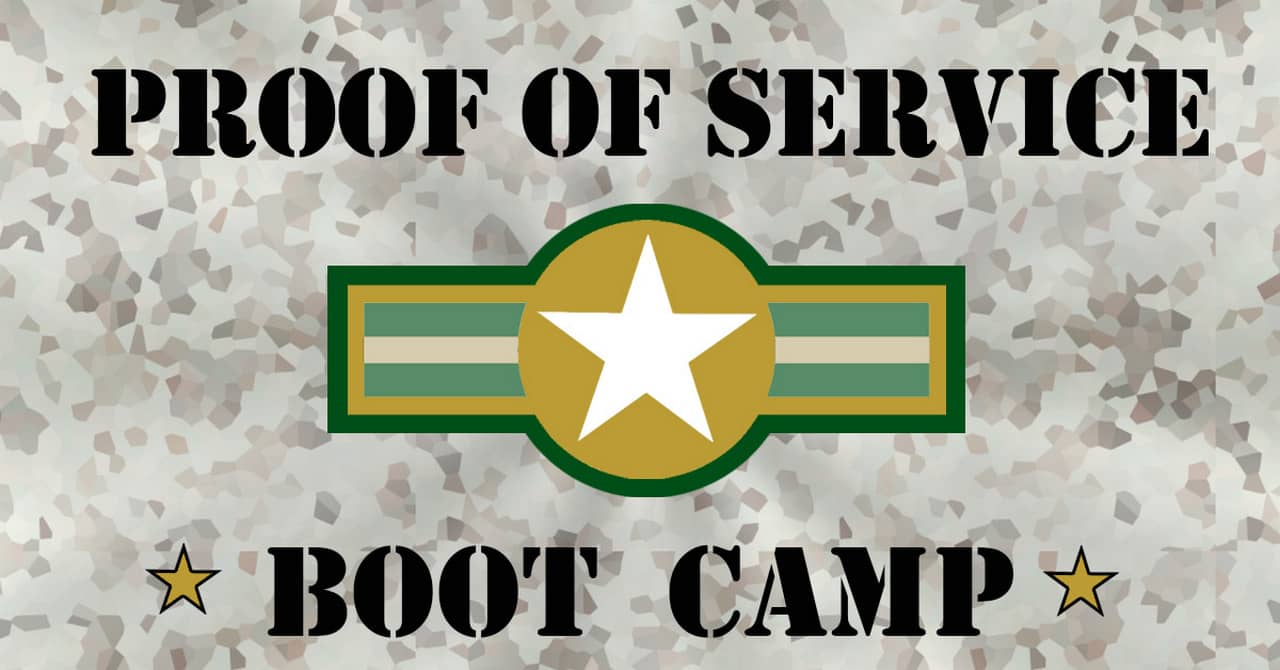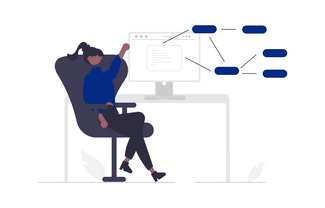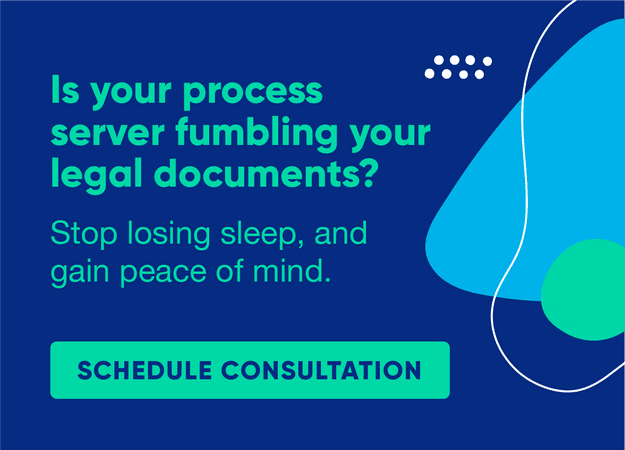
Proof of service is a small thing that makes a huge impact on a legal matter—especially if it’s not done correctly. We’ve designed this fact-packed crash course to build your proof of service expertise with the effectiveness of a Marine Corps boot camp, but without the push-ups and drill sergeant culture.
Without moving from your comfy chair, you’ll be razor sharp in no time about:
- What proof of service means for trials.
- How proof of service relates to service of process.
- Deadlines for filing proof of service.
- When proof of service is considered complete.
- Handling proof of service when court papers can’t be served.
Think you’re ready? OK, recruit, let’s move out!

Proof of service in a nutshell
When you make an important purchase, you always ask for a receipt. It’s the same with proof of service, which functions as a sworn statement that confirms court documents have been served on a party.
A proof of service form (sometimes referred to as a proof of service affidavit) records the name of the person served as well as the time, date, and location where the documents were served. The form describes the types of documents served, the way they were served to the party, and the process server’s name and signature.
Proof of service also acts as a failsafe device. In the event a defendant claims his or her papers were never served, proof of service says differently.
Now that you’ve got the basics, let’s put proof of service into context with its parent action: service of process.

What does ‘service’ mean?
For legal professionals who are new on the job or haven’t worked in litigation, here’s a quick primer about service of process. If your journey through this boot camp goes no further than this paragraph, this is an essential takeaway:
Service of process establishes jurisdiction.
Unless a court has jurisdiction over the party or parties involved in a legal matter there can be no trial.
For the party being sued, service accomplishes three things:
- Explains what the plaintiff is asking for.
- Establishes date, time, and place of the trial.
- Instructs the defendant about how to respond (i.e., explains choices).
Service of process uses specific types of court documents to launch legal matters, including trials. To help you visualize the relationship between these documents and their case types be sure to note Table 1 below.
Table 1.
Case initiating document
| Case type
|
Although there are some exceptions, all these documents must be personally served to the defendant or respondent before anything can proceed.
Documents such as discovery requests and discovery responses are not filed with the court, so the proof of service for these documents is not filed after the papers are served. The proof of service should, however, be signed for the law firm’s own records.
Wouldn’t it be nice to tackle two jobs at the same time?
File and serve allows you to simultaneously submit a file order and a service of process in just a few easy steps through an online portal:
- Upload the conformed copies as soon as the documents are filed.
- If the conformed copies are not readily available, request them from the provider.
- Know the service level of the serve order.
- Verify the documents.
It’s easy to start using file and serve today. Call now for details! (909) 664-9565.
Which type of service?
There are several ways to conduct service of process but two of the most common ways are personal service and substituted service.
- Personal service occurs when an individual gives court documents directly to the party being sued or to the agent authorized to accept service (this may be a business or public entity).
- Substituted service occurs when an individual gives the papers to an adult where the party named in the suit lives, works, or receives mail (including a private post office box, but not a U.S. Postal Service P.O. Box).
Check out The Ultimate Guide for Process Serving to see the full range of service of process methods. The guide is packed with ideas law firms can use to get greater value from service of process, including how to find out where you may be losing money on service of process orders.
Does my document have its own proof of service form?
If you’re uncertain whether a document used in a matter you are handling has its own proof of service form you can find out by checking with the court requirements.
If your document is not paired with its own proof of service form, you may use a general proof of service by mail form.
Watch this video for the step-by-step instructions to fill out a General Proof of Service by Mail form. If you use this form, be sure to give it scrupulous attention, though, because completing this form incorrectly may delay a matter or cause it to be dismissed.

When is proof of service complete?
The parties were located, documents handed over, now the matter may proceed, right?
Wrong.
After court documents have properly been served, the person who served those documents must complete and sign a proof of service affidavit, which attests to the service. That affidavit in turn is filed with the court.
This breakdown may help you more easily visualize the proof of service workflow:
- After papers are served the person who served the papers files a Form SC-104 Proof of Service with the court clerk.
- If the server used an alternate form, they must note each paper served on the alternate form.
- If service was completed by a registered server, the server must file the original proof of service directly with the court and mail you a copy of the filed form. That form may be taken to court and used as needed.
Remember: The original completed Proof of Service form must be filed 5 days before the trial.
If your proofs of service are taking too long to come back or seem less than rock solid use these 9 Questions to Ask a Process Serving Company to find out whether your vendor is up to the job.

Personal service doesn’t always work
Some parties will go to great lengths to avoid being served court papers. Divorce cases are one example where this scenario may play out. Once a server has exhausted the avenues of personal service set by the local court rules, substituted service may be used.
When such circumstances occur, the server provides proof of service using the following steps:
| 1. Write up a “Declaration of Due Diligence”. | This document details every attempt made to serve the papers in person. It should include the dates he or she went to the house or work, times of day, and the result (for example, “No one answered the door” or “Party not in the office”). |
| 2. Server signs this document under penalty of perjury. | There is no form for this, but the server can use a Declaration (Form MC-030). Some local courts may have a form to help with this step. |
| 3. Server fills out a Proof of Service. | This should detail when, where, and how the papers were served. The server must be sure to write the name of the person with whom he or she left the papers with (or a detailed physical description). The server signs the Proof of Service and returns it to you, with the Declaration of Due Diligence, to file in court. |
Substituted service is complete 10 days after the day the papers are mailed.
Other types of substituted service include:
- Service by Notice and Acknowledgement of Receipt
- Service by posting on the premises and mailing (for eviction cases only)
- Service by publication
- Service by posting (at the courthouse)
The proof of service methods these types of substituted service require are detailed on this California court website page.

Proof of service the easy way
No legal professional wants to spend the day wondering whether service was successfully completed.
Fortunately, there is an easy way to know as quickly as possible when service has been effected and that proof of service has been filed with the court: Use a qualified service of process provider.
Rapid Legal, for example, generally returns the proof of service within 2-3 business days from the date service takes place. Legal professionals who use Rapid Legal’s service of process receive an alert directly in their email inbox notifying them that service has been completed. This means they spend less time following up with vendors and worrying about their order status.
A range of service levels is available to meet the needs of a particular service of process order. They include:
| Standard | Document(s) scheduled to be dispatched for service on the next business day and will be attempted every 5 days thereafter. |
| Priority | Document(s) is scheduled to be dispatched for service on the next business day and will be attempted every other day thereafter. |
| Urgent before deadline (1:00 p.m.) | Document(s) scheduled to be dispatched for service same day and will be attempted every day thereafter. If the 4-hour time to serve is available, the customer can select the on demand service level, this is to be immediately dispatched for service and attempted within the 4 hour time to serve. |
| On demand | After deadline or within the 4-hour time to serve. |
| (Out of State) Urgent after 10 a.m. deadline | Document(s) scheduled to be dispatched for service on the next business day. |

Mission accomplished
Congratulations! You’ve graduated boot camp and have the skills you need to work your way through proof of service questions. You also have a better understanding of how proof of service fits in the service of process ecosystem.
Now it’s time to put Rapid Legal’s best-in-class performance to work for you. Make your move today to start receiving court-stamped documents and proofs of service fast, and reliably, with our portal that was designed to deliver maximum speed and accuracy.
Book a demo or schedule a call with an account manager now!
Get Started Today
Spend more time on billable client hours and less time tracking down conformed copies and proofs of service.

